Stuffing is Forgiving. And For Giving.
Cornbread + Sourdough Stuffing with Apricots, Fennel, Cinnamon, Cream, and Many Herbs
Excuse the dramatics, but it was a downright revelation when I learned that Thanksgiving stuffing could (and should) be made with heavy cream. And that when stuffing is treated more like a bread pudding than a bread-centric casserole, the gatherers would revel.
That edifying moment was 13 Thanksgivings ago, when I was a wee little cook, inspired by a big time chef I met on the job (Jason Franey, formerly of Canlis restaurant in Seattle) and his fussy but unbelievably special “unstuffing” recipe, in which you sous vide a roulade of venison sausage, prune, and chestnut stuffing— all bound with eggs and cream— and finish by flouring and frying thick slices in olive oil. No biggie.
That year, I spun his flavor combos into a stuffing of my own that I’ve made every year since. In unearthing his recipe for the sake of this newsletter, however, I was surprised at just how much more of a departure my ingredient list actually is from Franey’s. In my memory, I somehow thought I’d been totally carbon copying him, year after year.
The important components of his remain: Cream. Eggs. Brandy. Sage.
(Some of) my additions: Fennel (bulb, stalks, and fronds). Chile flakes. Cinnamon. Cornbread. Dried apricots.
There’s a lot of fanfare around food this time of year. I know cooks defend their age-old traditions, battle copious family requests, and face a trillion new dishes that tempt and tease. It’s tough being a new T-Day competitor trying to enter the recipe ring.
I picture my stuffing as a stick figure standing on the subway platform at Brooklyn’s Hoyt-Schermerhorn station: body made of stacked cornbread cubes, thighs and arms pudgy, formed from long, amorphous pieces of cream-soaked sourdough, with a fennel bulb bum, parsley locks of hair, a sage leaf hula skirt, a dried apricot beret with polka dots in the form of red pepper flakes, and a snifter of brandy in hand, garnished with a garlic clove. Heyyyy…. he’s cuuute! Everyone’s getting on the A train. The C. Another A. But Sir Stuffing is holding out for the G, because even though it’s so often passed over for more mainstream lines, he knows that the G will take him where no other train goes.
Some New Yorkers scoff at the G— it’s lesser known— and stick to their tried-and-true trains. But those who understand the value of the G— and all of the varied terrain it covers, from Queens to Greenpoint to Bed-Stuy to South Slope— revel in its trailblazery and spread the gospel of its reach. To these riders, under the spell of its greatness, the G is the only train that matters.
Here’s why riding with Sir Stuffing will win your heart and really take you places:
Cornbread. Plus Sourdough. Sweet + nutty meets sour + yeasty. You may never make a stuffing without the marriage of these two breads ever again. With crispy tops and edges and soft and bread pudding-y interior, expect a multi-faceted experience, through and through.
Cinnamon. Much like anchovy’s low key presence in a lot of dishes, the cinnamon here nearly escapes detection while still adding its woodsy-sweet depth, all without being too in-your-face HOLIDAY. Save the cinnamon surplus for the ‘nog.
Apricots. Their stone fruity brightness balances the stuffing’s intensely savory components: mucho onions, fennel, garlic, red pepper flakes, thyme, and sage.
Cream. Do you prefer French toast to toast? Rice pudding to rice? Soufflé to scrambled eggs? Benjamins to Hamiltons? You’re no fool. And neither is the cream.
The overall combo platter. I don’t know, NOODLERS, the experience of taste can’t always be put to words. The sum of these stuffing parts hit just right. Quite simply, there’s something to be said about sage + brandy + fennel+ cinnamon + cream. And don’t be afraid of the quantity of salt. There are measurements in the recipe for a reason!
SOME RECIPE NOTES
On cornbread: I recommend making it from a boxed mix (or from scratch) rather than buying pre-baked from a store. Why? Because you can make it better at home, with the following trick: Before baking, add 1/4 cup of cream to the cornbread batter. People often complain about cornbread stuffing being inherently dry, and this is a great solve.
If using Jiffy brand for this recipe, make two boxes worth and bake the doubled batter in one singular pan, to increase height. One of the best cooks I know (and one of my greatest mentors… hi, Mastracco!) will stand by Jiffy cornbread ‘til the end of time. If you’re down to clown with a homemade cornbread, this recipe would be phenomenal, too.
On brandy: You can sub white wine! Or chicken stock! I love brandy for its underlying evocation of the holidays, but totally your pick.
On fennel: USE IT ALL. Thinly slice the stalks (even if they’re super long!), chop up those fronds, and toss them all in with the chopped bulbs when sautéing. Flavor on flavor on flavor.
P.S.
I almost titled this newsletter “Putting ‘the Stuff’ in Stuffing” and thought quickly, “nah… that phrase has gotta already be a thing.” Did some research and turns out… it has yet to be claimed. Who’s up for making some tees?
CORNBREAD + SOURDOUGH STUFFING WITH APRICOTS, FENNEL, CINNAMON, CREAM and MANY HERBS
Serves 8-12
REMEMBER, BEST PRACTICE: READ THE RECIPE ALL THE WAY THROUGH BEFORE YOU START COOKING!
I love the texture and flavor combination of cornbread with a classic San-Francisco style sourdough. Best of both worlds here.
And speaking of cornbread: I like to make it from a mix, rather than purchase. Why? So that I can add a big splash (a healthy ¼ cup) of cream to the batter before baking, which makes the cornbread sooo delicious and all the more so for stuffing. Use 2 (8.5-ounce) packages of Jiffy mix (baked all together in one pan, for height) or 1 larger box (15-ounce) cornbread mix. (The Whole Foods brand is 15 ounces and quite good.) You may have a bit leftover to snack on after using what’s called for in the recipe. (One more reason to bake it with cream.)
Assembling this dish one full day in advance is the ultimate way to save time on Thanksgiving. Plus, the bread will completely hydrate when left to sit overnight. Dry stuffing this is NOT.
One large round classic sourdough bread (about 1 - 1 ¼ pounds), or another rustic bread
1 pound cornbread, cut into 1 ½-inch cubes (about 5 heaping cups) *See headnote for cornbread tips
12 tablespoons (1 ½ sticks) butter, plus 4 tablespoons, melted, for drizzling stuffing before baking
¼ cup olive oil, plus additional for greasing
2 large onions (about 1 ¼ pounds), peeled and roughly chopped
1 very large or 2 medium fennel bulbs, roughly chopped, including all stocks and all fronds
5 stalks celery, thinly sliced
5 cloves garlic, peeled and roughly chopped
Kosher salt and freshly ground black pepper
⅓ cup (packed) chopped sage (from 1 bunch)
¾ teaspoon ground cinnamon
½ teaspoon red pepper flakes
5 large eggs
1 ¼ cups heavy cream
⅔ cup brandy (substitute white wine or more chicken stock, if desired)
2 cups low-sodium chicken stock, plus additional as needed
Leaves from 1 large bunch flat-leaf parsley (about 2 packed cups), roughly chopped
Leaves from 10 sprigs thyme sprigs, chopped
10 ounces (about 1 ½ cups) dried apricots, quartered or halved if small
1. Heat the oven to 350 degrees with racks in the upper and lower thirds.
2. Prep and toast the bread: With a sharp serrated knife and leaving behind as much of the interior bread as possible, remove the bottom crust of the sourdough loaf. Discard or save for breadcrumbs. (The crust that you’ll get from the other parts of the loaf is plenty. A ton of crust in a stuffing? Not my favorite.) Doing your best not to smoosh the bread as you pull, gently rip the loaf into rustic 1- to 2-inch pieces and place on a baking sheet. (Using a fork for this step is helpful, so as to keep the bread pieces light and fluffy.) You should have about 8-10 (not packed) heaping cups.
3. Add the cornbread cubes to a second baking sheet. Transfer both baking sheets to the oven and bake until bread is dry and ever so slightly golden, about 25 minutes. The cornbread may need longer, depending on how fresh it is. (You can skip this toasting step if you have the forethought to dry out the bread bits in advance: leave uncovered on baking sheets at least 24 hours or up to 3 days in advance.)
4. Grease a 9” x 13” pan with olive oil. Place 12 tablespoons of butter and ¼ cup of olive oil in a large Dutch oven over high heat. When the butter has melted, add the chopped onions, fennel (plus chopped stocks and fronds), celery, garlic, 1 tablespoon salt, and a very generous amount of freshly ground black pepper. Sauté, stirring occasionally, until the vegetables are thoroughly softened, about 8-10 minutes.
5. Add the sage, cinnamon, and red pepper flakes. Continue cooking, reducing heat as necessary to prevent scorching, until the mixture has seriously shrunk and begins to take on a more jammy consistency, about 8-12 minutes more. (The vegetables should still retain their shape.) Remove from the heat.
6. Combine the eggs, heavy cream, brandy, low-sodium chicken stock, 1 tablespoon of salt, and a generous amount of black pepper in a large bowl. Whisk to combine.
7. Place the sourdough and cornbread cubes into the largest mixing bowl you have, along with the parsley, thyme, and about three-fourths of the apricots. Scrape the onion mixture into the bowl and use a large spatula to fold gently until the bread pieces are well-coated. Pour the egg mixture over the bread and continue tossing. Let sit for a few minutes, and then toss again. Repeat until the bread has absorbed nearly all of the liquid. If the mixture seems dry (each bread cube should feel nicely saturated), add a touch more chicken stock. Season to taste with salt and pepper. Transfer to the prepared pan, making sure to mound the stuffing rather than pack it into the pan. (If you have extra that’s not fitting, you can bake it in a small baking dish.) Sprinkle the remaining apricots on top of the stuffing, tucking them in between the crevices. (Yes, this is purely a visual thing, so as to show off the orange gems.)
8. Let the stuffing sit for at least 1 hour. You can make the stuffing up to this point one day in advance. Keep covered in the refrigerator.
9. When ready to bake, heat the oven to 375 degrees with a rack in the center. Drizzle the top of the soon-to-be stuffing with the remaining 4 tablespoons of melted butter. Cover with a lightly greased piece of tin foil and transfer to the oven. If baking from room temperature, bake 30 minutes, until heated through, sizzling on the sides, and somewhat puffed. (Add 10 minutes if baking from refrigerated.)
After this first phase of baking, you can hold the stuffing for a couple of hours if desired until nearly ready to serve, which can be helpful when negotiating precious oven space. When about 30 minutes away from serving, uncover the pan and increase the temperature to 425 degrees. Continue baking until lightly golden on the top and the interior is completely baked through, about 20-25 minutes more. Serve.




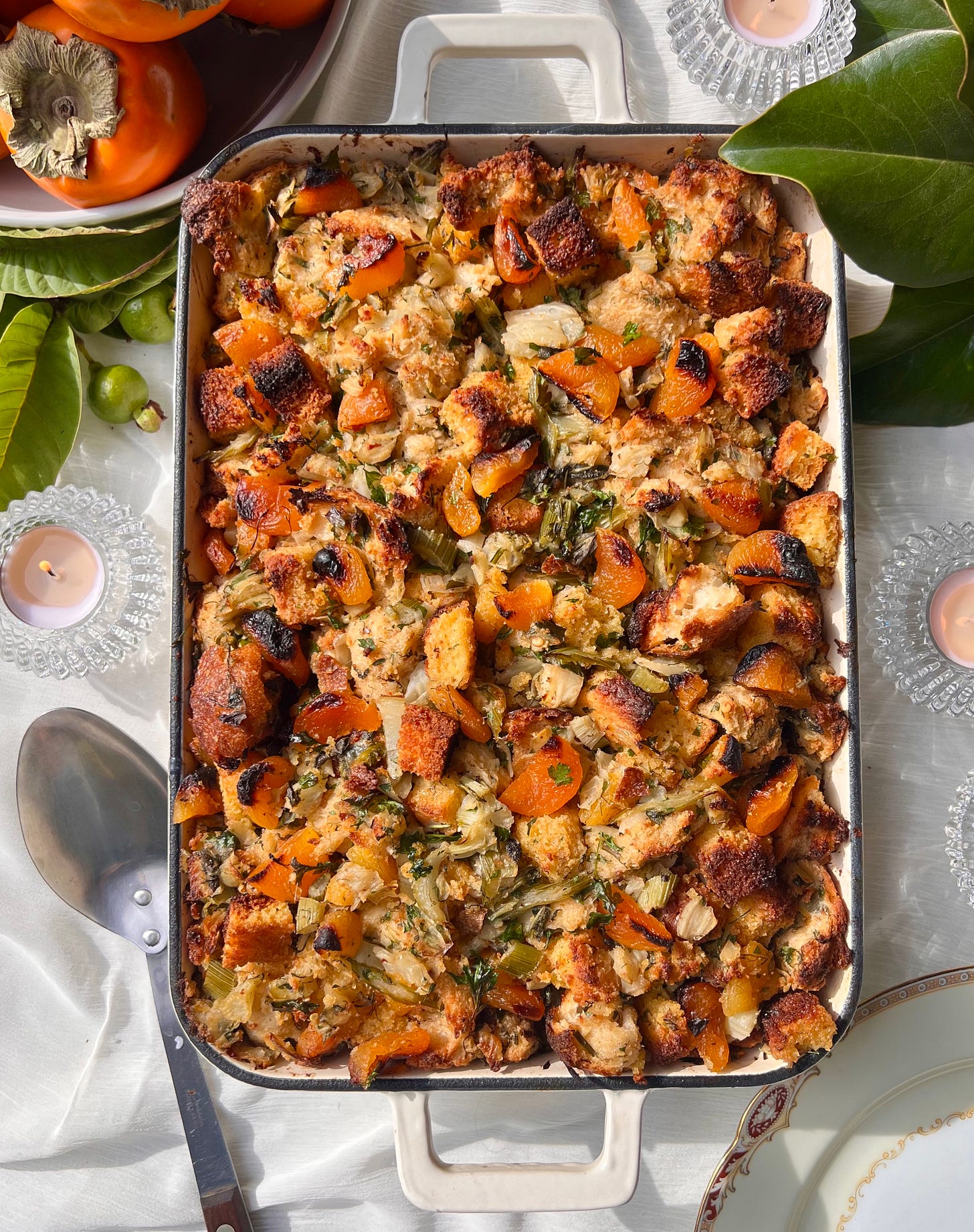
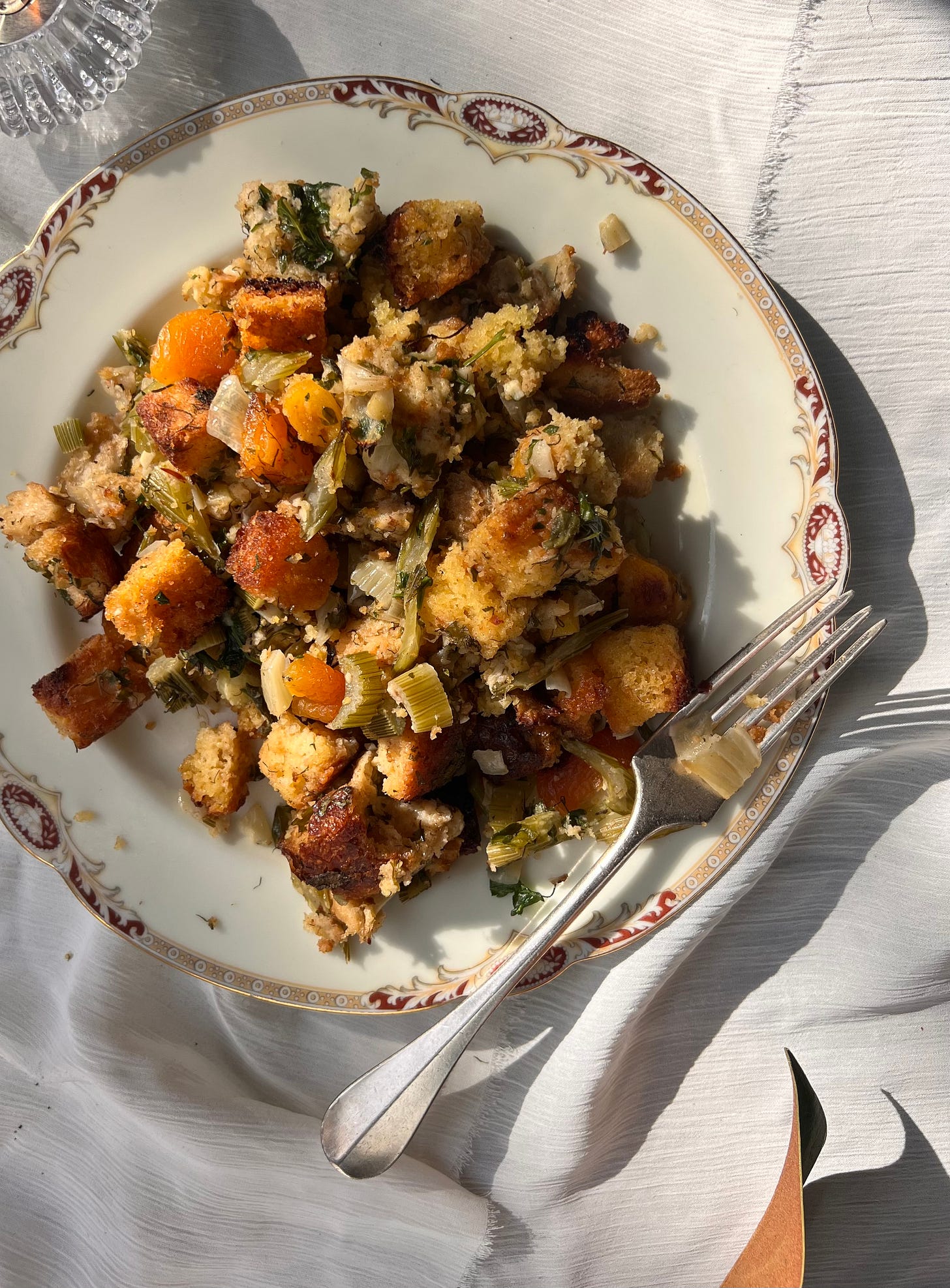
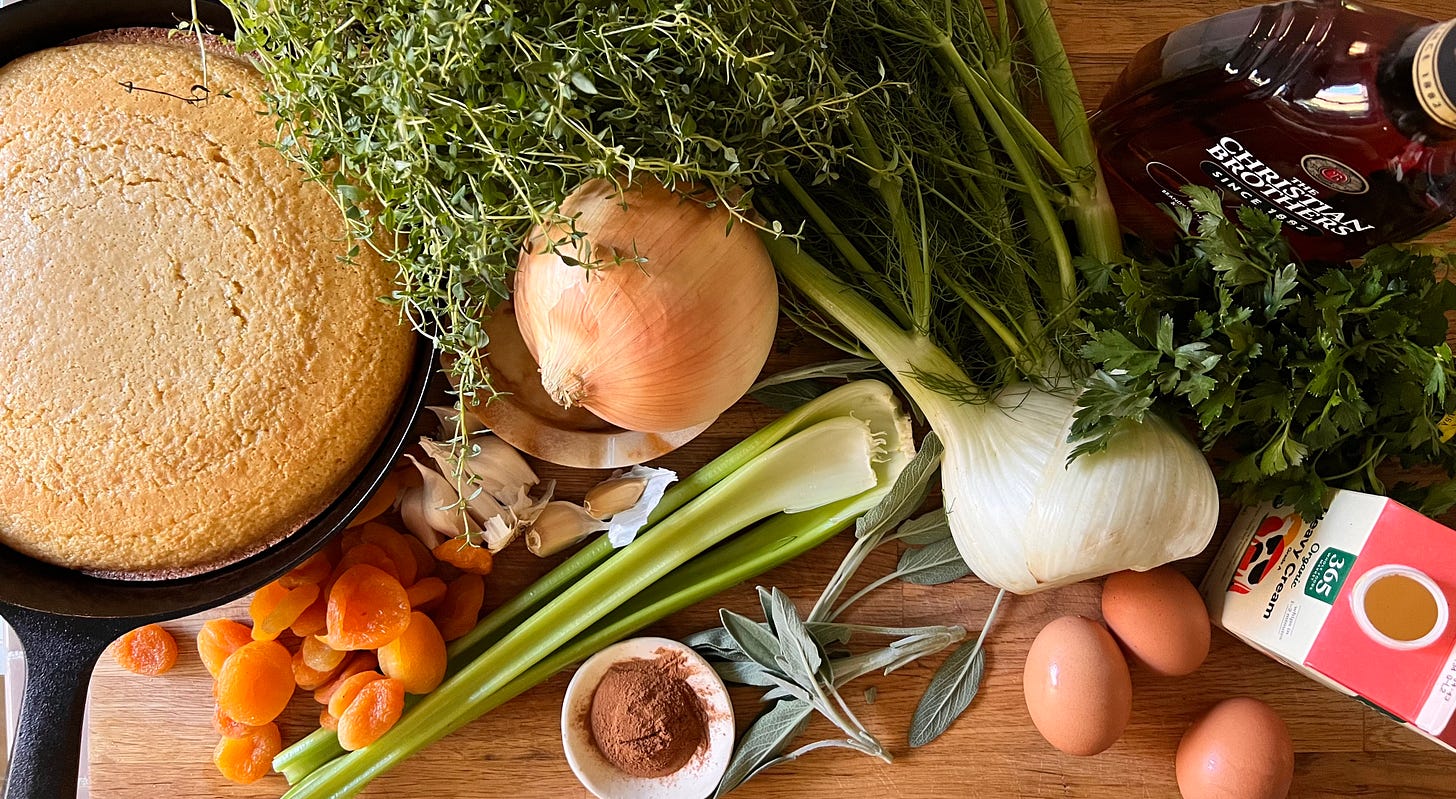
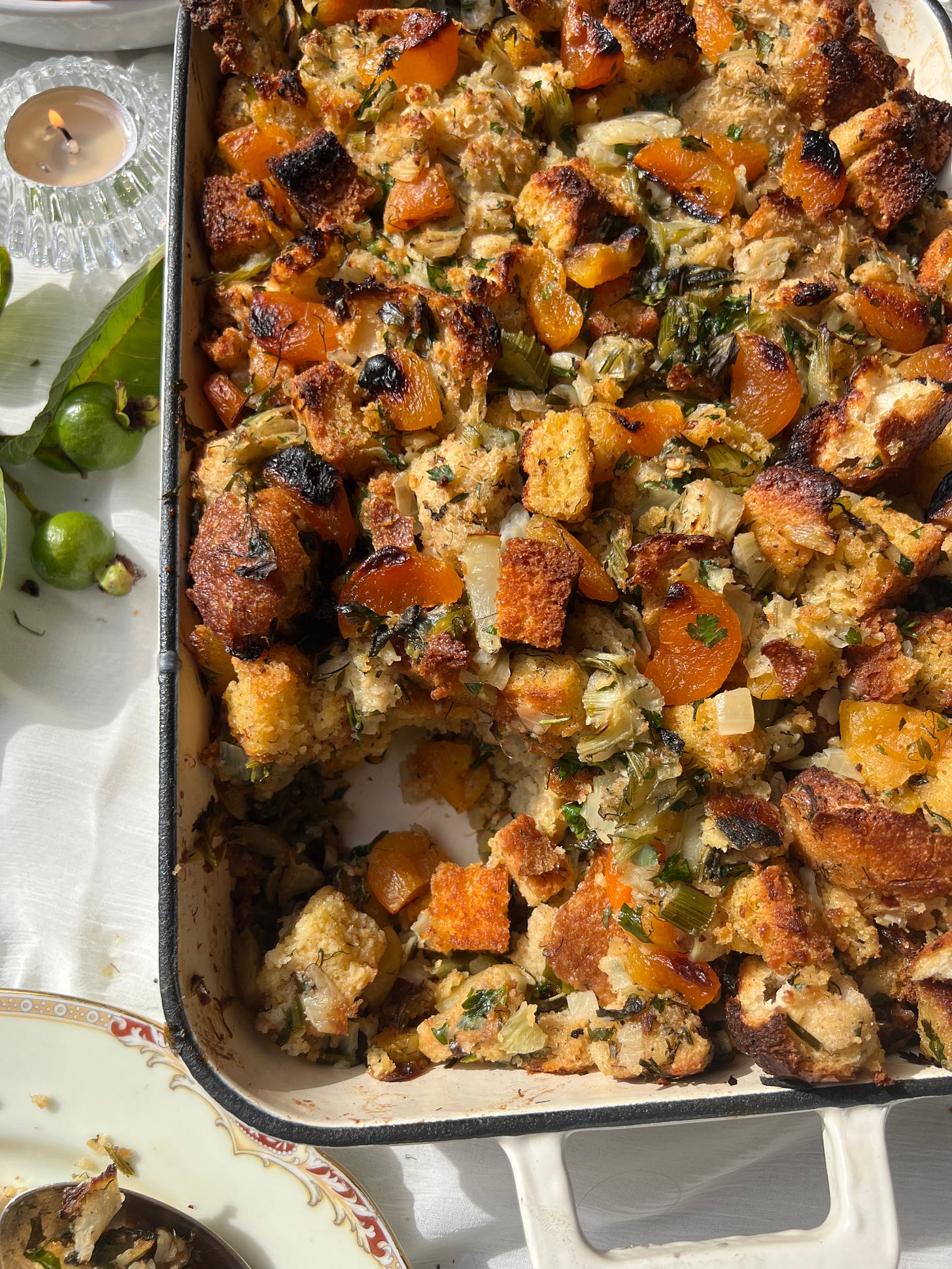
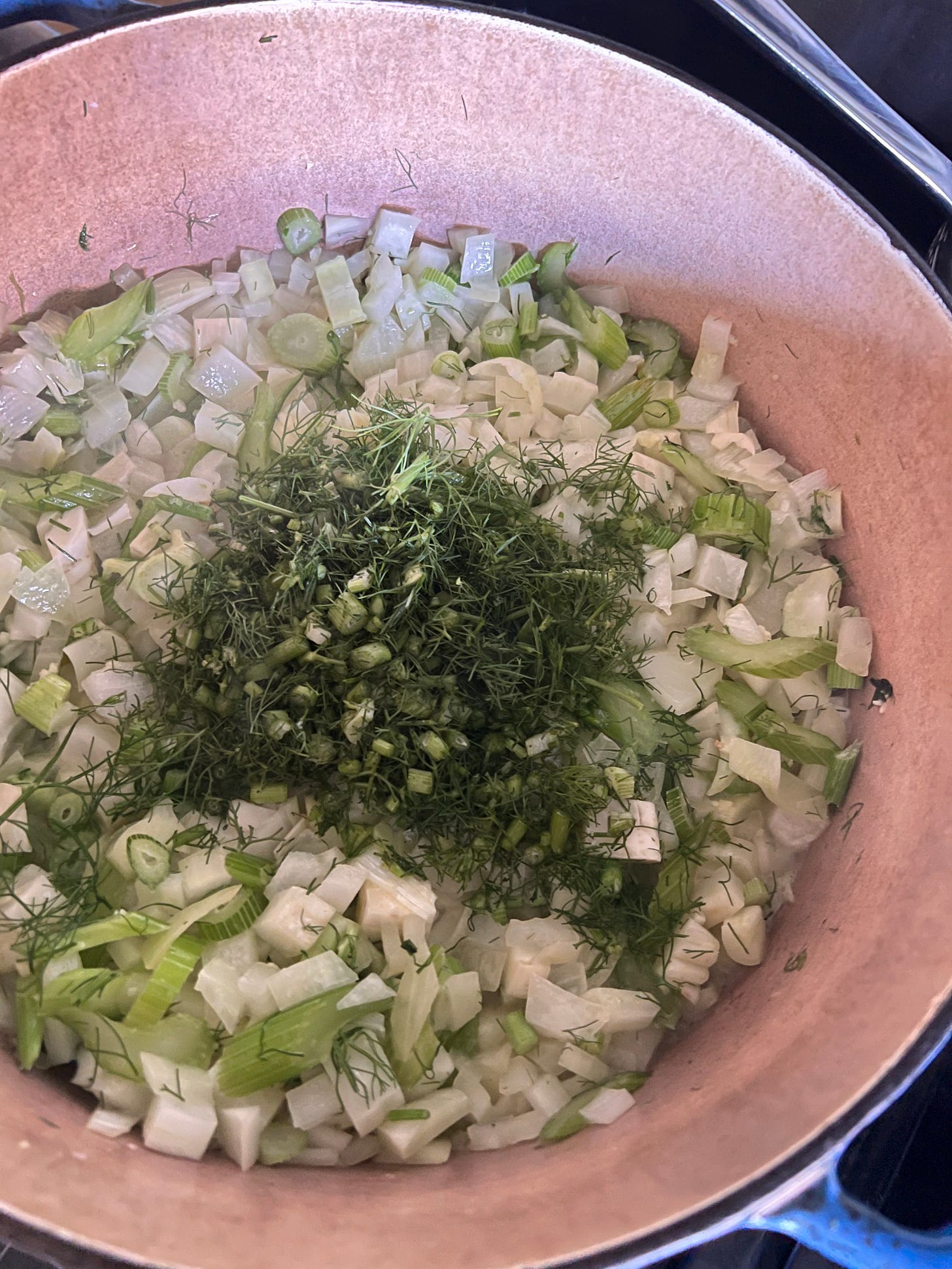


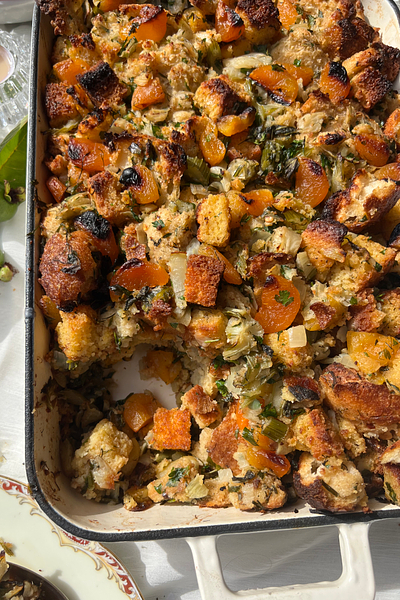

I am among the privileged few who got to taste this work of art pre-post and assume I am the only person who hauled a gallon ziploc bag full of it up the length of the west coast. I shared the magic with my family and have been told they will accept no stuffing other than this moving forward. 🧡